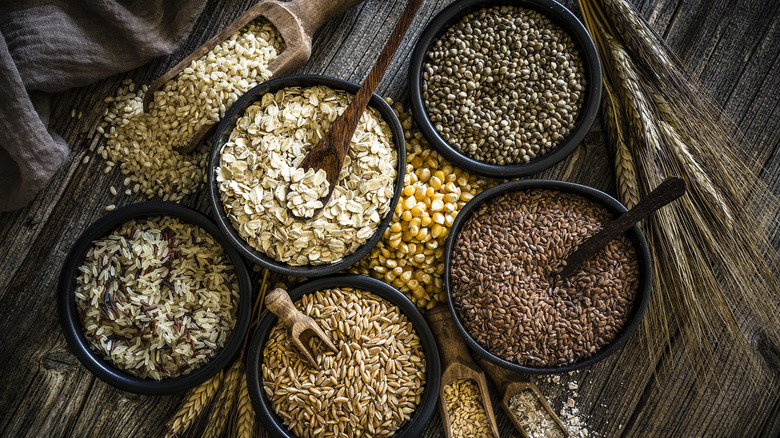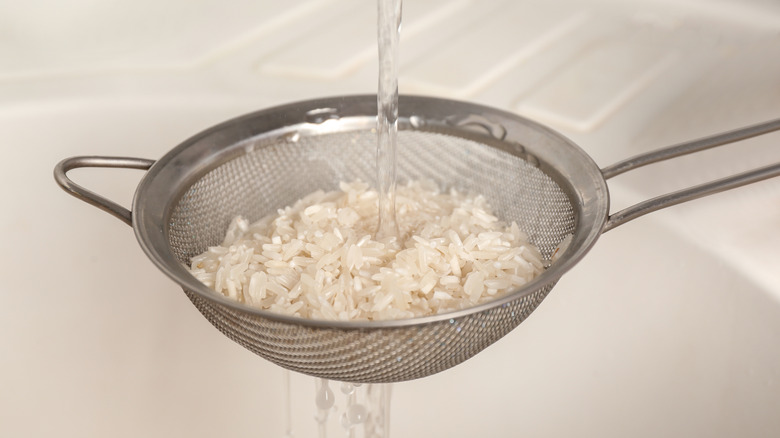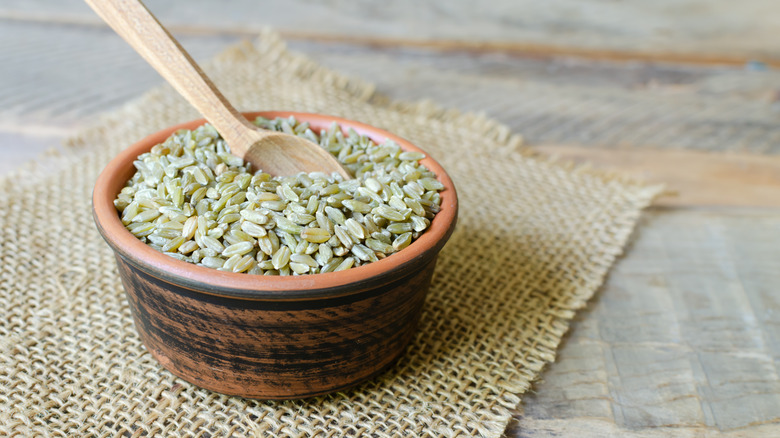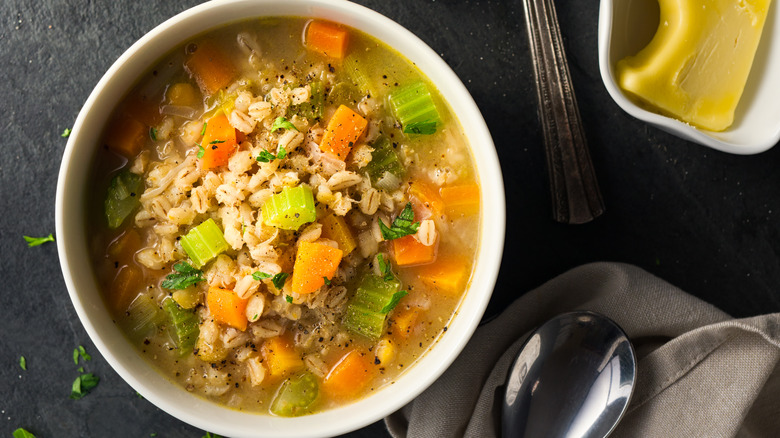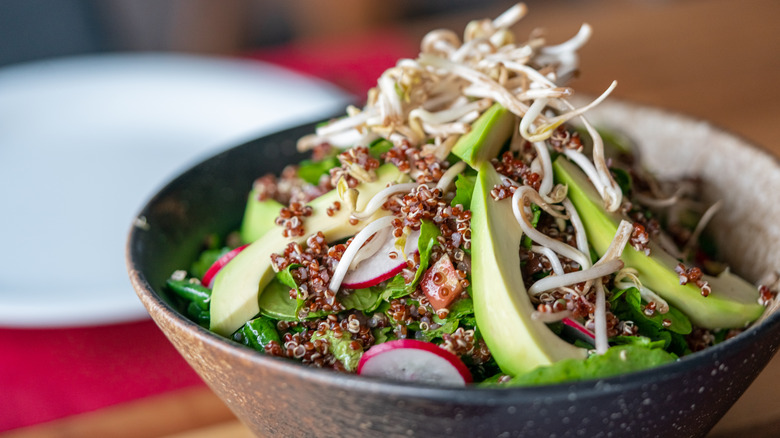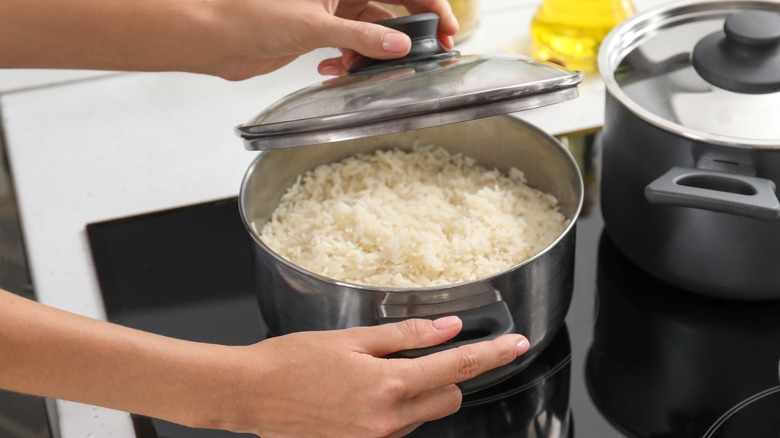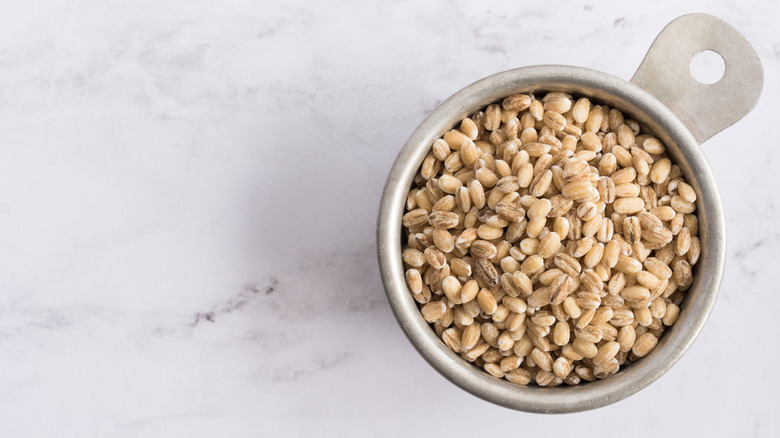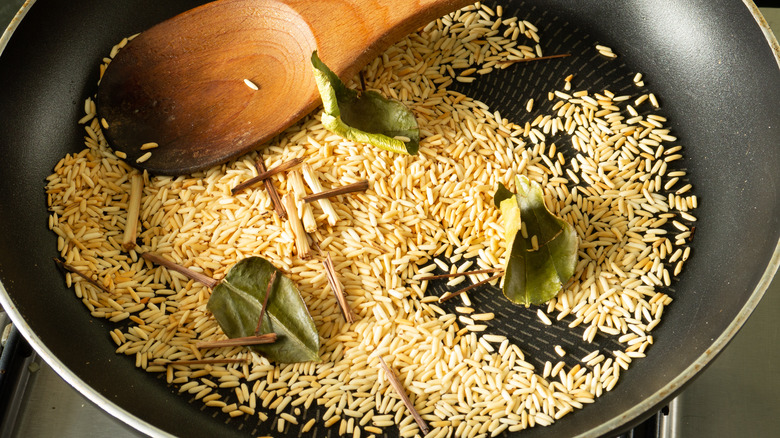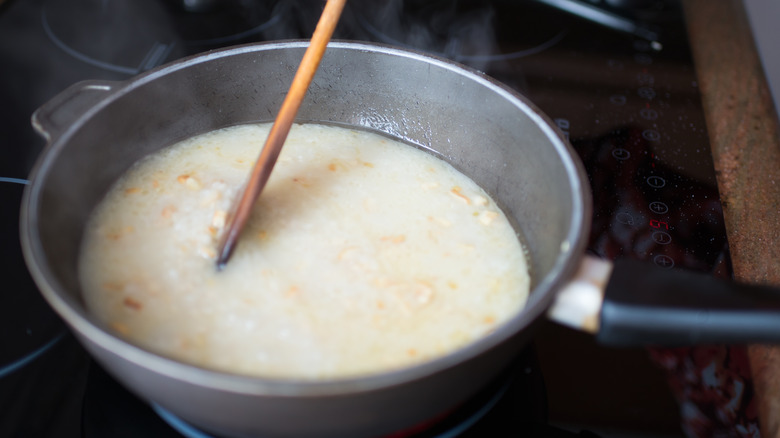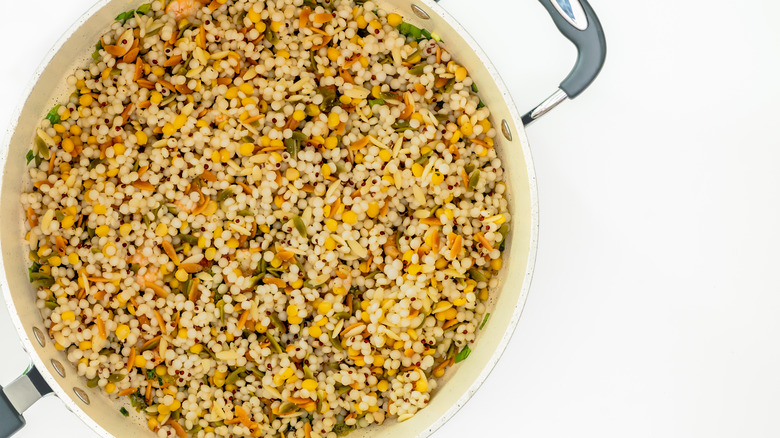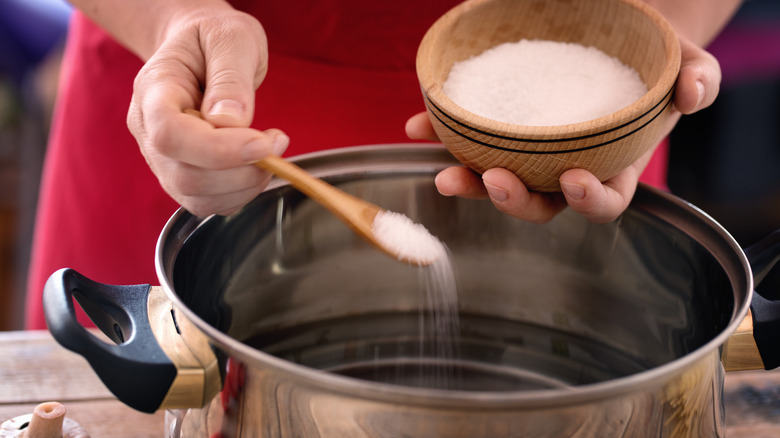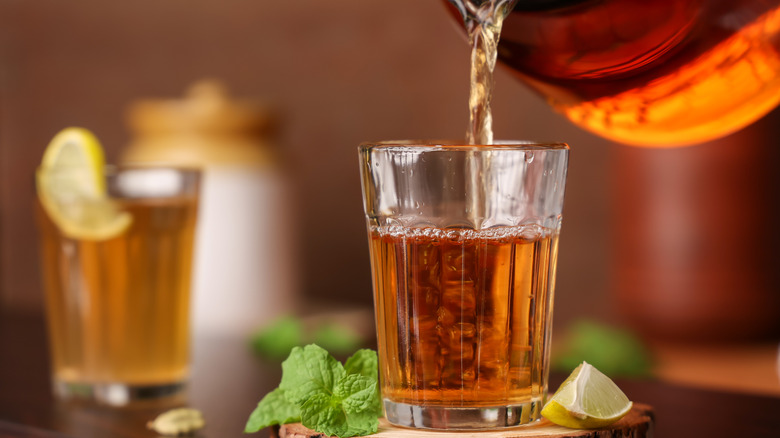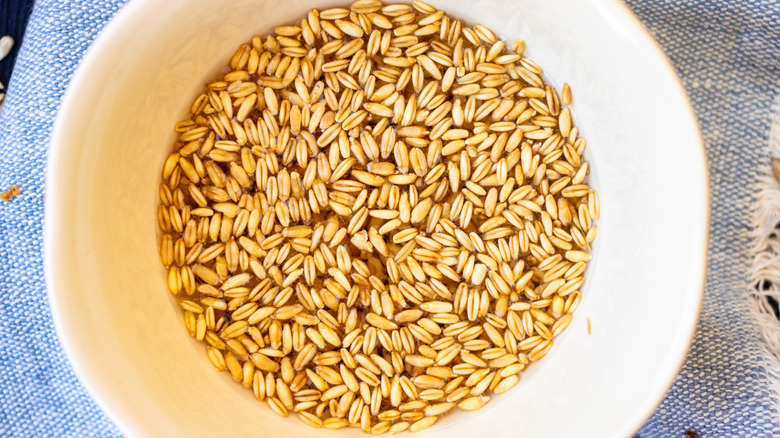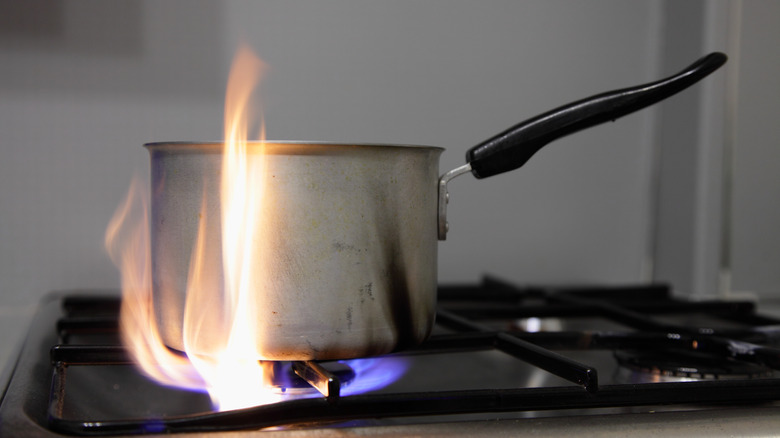Mistakes Everyone Makes When Cooking With Grains
Grains are a staple in many people's diets. From common favorites like rice and oats to more unusual offerings such as teff and amaranth, there are plenty of grains to add to your diet. They play a crucial role in meals, since they're filling and delicious. Yet it's not uncommon for people to make a range of mistakes when cooking with grains. If you want to improve your culinary skills, it's important to identify and avoid these pitfalls.
Thankfully, you've come to the right place to up your grain game. In this article, we'll uncover the nuances of grain cookery, shining a light on prevalent mistakes that can affect the outcome of your dishes. From misjudging water ratios leading to overly moist grains to overlooking the impact of toasting, there are many mistakes you can make. But once you know what they are, they're easy to avoid. As we navigate the processes of cooking grains, both beginners and seasoned cooks can reflect on and enhance their skills.
Now's your chance to refine your approach to cooking grains. If you have a mental block when it comes to cooking grains outside of your comfort zone or if you're still trying to perfect rice, there's plenty of information to guide you here. So let's take a look at these common mistakes everyone makes when cooking with grains.
Not rinsing grains
Rinsing your grains might seem like a mundane step, but it often holds the key to elevating your dishes. This practice, often overlooked or hurriedly performed, can affect the flavor and texture of cooked grains. Rinsing grains removes excess surface starch. This starch, if left unattended, contributes to a gummy or sticky texture in the final dish. By giving these grains a thorough rinse under cold water, you effectively wash away the starchy residue, resulting in a fluffier and more separate end product. This step is particularly crucial for varieties like basmati and jasmine rice, where achieving that perfect individual grain structure is paramount.
What's more, rinsing can eliminate impurities and the bitter outer coating often found on quinoa and some other grains. Quinoa, in particular, possesses a natural protective coating called saponin, which can impart a bitter taste if it's not adequately rinsed. By subjecting quinoa to a good rinse, you not only enhance its flavor but also contribute to a more enjoyable dining experience. You'll also be washing away dirt and debris that might be leftover on some grains after processing.
Rinsing grains might be a simple step, but it's one you shouldn't overlook. Rinsing improves the texture and flavor of your favorite grains, so it's worth spending the short amount of time it takes to do it.
Cooking the same grains over and over
Sure, common grains such as rice, oats, and quinoa are great, but if you aren't exploring the world of lesser-known grain varieties, there's a lot you're missing out on. So what grains should you be cooking with? Well, there's farro, which is an ancient wheat grain with a nutty flavor and chewy texture. It's versatile and works well in salads, soups, or as a side dish. You also have freekeh, a green wheat that's roasted and cracked, imparting a smoky flavor. It can be used as a base for pilafs or in salads.
And let's not forget about teff, a tiny gluten-free grain that's native to Ethiopia and has a mild, nutty flavor. It's often used to make injera, a type of Ethiopian flatbread, but can also be cooked as a porridge or added to baked goods. Sorghum is another gluten-free grain, this one with a slightly sweet taste. It can be popped like popcorn, cooked into a porridge, or used as a base for salads.
Kamut is an ancient wheat variety with a rich, buttery flavor. It's often used in pilafs, salads, or as a side dish. Amaranth is another ancient grain with a peppery and nutty flavor. It can be cooked as a porridge, added to soups, or popped like popcorn. And that's just the start of all the grains there are to try.
Not adding grains to soups
Soup is the ultimate comfort in a bowl, but you can make it even more hearty by adding grains to the mix. Grains bring a unique texture to soups, creating a satisfying and hearty base. Barley, with its chewy consistency, adds a wholesome element, turning a simple broth into a substantial meal. Quinoa, often recognized for its stellar protein content, imparts a subtle crunch, transforming soups into a textural adventure. Farro, with its nutty flavor, not only enhances the taste but contributes a satisfying bite that complements the softness of other ingredients.
What's great about grains is that you can integrate them into a variety of soup genres. In a vegetable soup, adding quinoa or wild rice makes them more filling and brings an appealing texture. Barley finds its perfect home in hearty soups, imparting a robust character to the broth. Lentil soups benefit from the addition of rice, especially when infused with Indian or Middle Eastern flavors.
If this wasn't enough, grains absorb the flavors of the broth, infusing each bite with the essence of the soup. This makes the grains tastier while simultaneously making your soup more filling and more of a meal, so everyone's a winner.
Not using grains in salads
Salads are getting a makeover, and grains are stealing the show, turning those leafy greens into hearty, satisfying meals. Grain salads are a great way to make a filling, balanced meal and there's lots to love about them, too. First, let's talk texture. Quinoa brings a delightful nutty crunch, while farro steps in with its chewy goodness, giving your salad that hearty feel. And who could forget bulgur? It's light and fluffy, working well with crispy veggies.
But grains are bringing serious nutritional game to the salad party. Brown rice and freekeh are full of fiber. And quinoa is a complete protein, as well as being fiber-packed. It's this fiber that helps make you feel more full than you would after a plate of just veggies, which is part of why grains are so good in salads.
If you're looking to branch out, what grains should you try? Quinoa effortlessly mingles with vibrant veggies, making your salad Insta-worthy and nutrient-packed. Farro plays best with roasted veggies and robust greens, turning your bowl into a flavor fiesta. And bulgur? It's the Mediterranean breeze in your salad, teaming up with olives, tomatoes, and feta.
Grains are also great in salads with plenty of dressing because they soak up that dressing like a sponge, making it taste even better. Whether you're tossing together a breezy summer salad with couscous or a protein-packed bowl with barley, grains are turning salads from a side act to the main event.
Cooking them too long or not long enough
Cooking grains for too long or not long enough is a mistake that can impact the overall quality of your dish. Cooking grains for an extended period can turn them into a mushy, unappetizing affair. Overcooked rice, quinoa, or barley becomes like a homogenous mass that lacks the satisfying bite and distinct grain structure.
On the flip side, undercooking grains denies them the chance to fully express their potential. Hard, crunchy grains not only fail to deliver the desired palatability but are also tough to digest. Incomplete cooking may leave behind an undesirable raw taste, so your food just won't be as good.
Each grain has its own ideal cooking time, and mastering this balance is key to achieving the desired results. From the tender fluffiness of perfectly cooked rice to the toothsome bite of al dente quinoa, the journey hinges on precision. For instance, bulgur only needs to be cooked for 10 to 12 minutes, while hulled barley needs 45 to 60 minutes. This is a big difference and can lead to confusion. Make sure to check the cooking time for the type of grain you're making to get the optimal results.
Not using the correct grain-to-water ratios
One of the most common mistakes people make with grains is using the wrong ratio of grains to water. This can mean the difference between culinary triumph and potential disaster. The proper grains-to-water ratio determines the texture of your cooked grains. Too much water can lead to a soggy, unappetizing result, while too little can result in undercooked and hard grains. It's the sweet spot between these extremes that gives you grains that absorb just enough water to reach that perfect, toothsome tenderness.
But it isn't as easy as just learning one formula and sticking to it. Each grain has its own grain-to-water ratio. For instance, 1 cup of barley needs 3 cups of water to cook properly, while 1 cup of quinoa needs 2 cups of water. Sure, you might remember the ratios for your favorite grains over time, but you'll probably need to look up the right ratios for lesser-known grains or whenever you're unsure.
Not realizing that toasting grains is an option
Toasting grains is the secret to unlocking a depth of flavor that can elevate your dishes. It's a transformative step that adds a layer of nuttiness, warmth, and complexity to grains. Toasting grains isn't just about adding a touch of color; it's a flavor infusion. The process unlocks the aromatic compounds within the grains, intensifying their natural flavors and introducing new dimensions. Whether it's the earthy richness of quinoa or the comforting warmth of farro, toasting enhances and deepens the overall taste profile.
Toasting grains is a simple yet impactful process. Start by heating a dry skillet or pan over medium heat. Add your grains — whether it's rice, quinoa, or farro — and spread them evenly in a single layer. Keep a watchful eye and stir occasionally to ensure even toasting. The grains will gradually change color, adopting a golden hue and releasing a delightful aroma. For a more intensified flavor, consider adding a touch of oil or butter to the pan before toasting. This not only enhances the toasting process but also contributes a luscious richness to the grains. You can also toast them in the oven at 350°F for around 15 to 20 minutes.
Once your grains have achieved that golden perfection and the aroma has filled the air, remove them from the heat. Now, you can cook your grains as normal and savor those extra toasty notes.
Stirring certain grains
You may have heard that you shouldn't stir grains during the cooking process. While there's some truth to this, it isn't the whole story. Stirring rice during the cooking process risks breaking the grains, leading to a potentially mushy, unappetizing end result. The magic of perfectly cooked rice lies in each grain retaining its individuality, creating a light and fluffy texture that dances on the palate. So if you're always wondering why the texture of your rice isn't ideal, this might be where you're going wrong.
Rice benefits from a hands-off approach. Allowing it to simmer undisturbed ensures that each grain absorbs the liquid evenly, achieving the desired tenderness without compromising its integrity. It's a lesson in simplicity — letting the grains and the water perform their magic without interference. However, the same can't be said for other, heartier grains. You can stir these without risking them breaking.
Thinking boiling is the end of cooking
Boiling grains might mark the end of the cooking process, but it certainly doesn't conclude the culinary journey. For those seeking to transcend the ordinary and infuse their grains with a burst of flavor, the secret lies in a post-boiling encore: stir-frying with oil or butter and aromatic companions.
Stir-frying grains in a sizzling pan with a drizzle of oil or a pat of butter adds flavor. The addition of aromatics — garlic, onions, or spices — takes their taste to the next level. If you're sick of bland or uninspiring grains, this could be the answer. This technique not only imparts a rich, nutty undertone to the grains but lets them absorb the aromatic essence of the extra flavorful ingredients you add. Plus you get a pleasantly firm texture. If you like fried rice, this is a similar process but you can do it with any grain.
So, let the boiling be the prelude, and the stir-frying be the crescendo. Elevate your grains from mere sustenance to something truly special. The simplicity of a well-seasoned stir-fried grain dish is a testament to the transformative power of a sizzling pan and a touch of culinary imagination.
Not salting cooking water
If you're not salting the water you use to cook your grains, what are you even doing? It might seem like a no-brainer, but so many people make this mistake when cooking grains that we thought it was worth mentioning. The humble act of salting the water that you cook your grains in can transform them from criminally bland to pleasantly flavorful. Salt, as it dissolves into the boiling water, permeates the grains, awakening their natural flavors and contributing to a well-rounded taste profile. This simple yet effective technique ensures that each grain absorbs the salt, resulting in a dish where the seasoning is not merely on the surface but ingrained in every bite.
However, there's a delicate balance to be struck. While salt is a flavor enhancer, it's crucial to avoid the temptation to oversaturate the water. Too much salt can overpower the grains, leading to an end product that's slightly over-salted at best and inedibly salty at worst. There's some degree of kitchen intuition that lies with adding the right amount of salt that you can only learn with time. So if you're unsure, start small or follow a trusted recipe.
Only ever using water to boil grains
There are so many tasty liquids out there, so why would you only ever use water to cook your grains? Replacing water with stock or broth is a game-changer. Whatever stock you choose, these liquids add layers of complexity to your grains. Or, for a creamy, indulgent choice, consider cooking your grains in coconut milk. The luscious creaminess of coconut milk imparts a subtly sweet and nutty undertone to the grains. It's great for cooking grains you're going to eat alongside a curry.
Vegetable juice, whether homemade or store-bought, can add some delicious flavors to your grains. From the earthy sweetness of tomato juice to the refreshing notes of carrot or celery juice, the possibilities are endless.
It might seem unusual, but cooking your grains in tea is another choice that introduces an aromatic dimension. Whether it's the floral notes of chamomile, the smokiness of lapsang souchong, or the herbal infusion of green tea, using tea as a cooking liquid imparts a subtle and intriguing flavor profile to your grains. You could even use chai to cook spiced grains.
Finally, if you're interested in a boozy twist, consider cooking grains in wine or beer. The acidity, richness, and nuanced flavors of these beverages add a gourmet touch to your dish. From a robust red wine to a light beer, the grains become a canvas for the complex notes of these liquids.
Thinking grains need to be soaked before cooking
A culinary misconception that has persisted through generations involves the belief that certain grains require soaking before cooking. The reality is, this practice is often unnecessary, and the time spent soaking might be better used elsewhere.
While soaking has its merits for legumes and certain seeds, many grains don't significantly benefit from this pre-cooking ritual. Grains like rice, quinoa, and farro can be cooked to perfection without the need for an overnight bath. The notion that soaking grains improves their texture or reduces cooking time is, more often than not, a culinary myth.
In fact, cooking unsoaked grains can yield similar results, saving you precious time in the kitchen. Plus, once you know that you don't have to soak your grains, this gives you more flexibility in the kitchen. Rather than having to prepare 12 hours in advance for a grain-based meal, you can cook any grains you like on a whim.
Modern cooking techniques and the quality of commercially available grains often mean that the benefits of soaking are marginal at best. So skip the soaking step, streamline your cooking process, and you can still enjoy delicious, perfectly cooked grains without succumbing to the unnecessary tradition of soaking. It's time to debunk this culinary myth and reclaim those minutes for more enjoyable kitchen endeavors.
Using too high a cooking temperature
One complaint we hear often is that, no matter what people do they always end up with grains burning to the bottom of their pan. Well, this is often simply a result of having your burner set too high. Too high a temperature can turn the bottom of the pot into a battleground, where grains risk sticking, and ultimately burning. This not only imparts an undesirable taste to the dish but also mars the intended texture and leaves you with a pot that requires a fair bit of scrubbing.
Maintaining a steady heat allows the grains to simmer and absorb the liquid evenly, resulting in a uniform tenderness and flavor distribution. So instead of whacking the burner up to high and hoping for the best, take it easy. As soon as your grains come to a boil, turn the burner to the lowest setting for the cooking time. Some people also choose to cook grains in the oven rather than on the stovetop to avoid burning, or to use a rice cooker for the perfect result.
